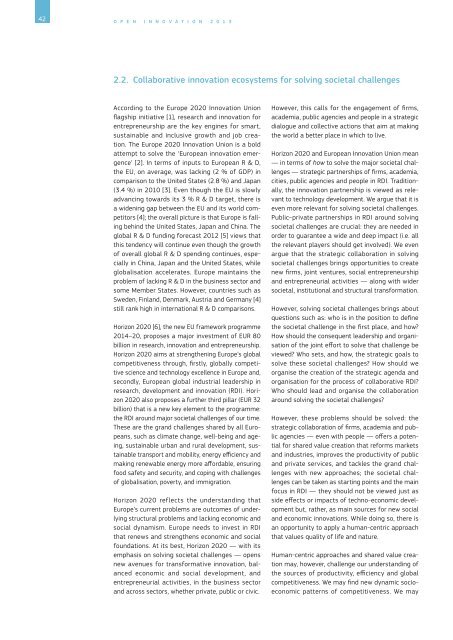Open Innovation 2.0 Yearbook 2013 - European Commission - Europa
Open Innovation 2.0 Yearbook 2013 - European Commission - Europa
Open Innovation 2.0 Yearbook 2013 - European Commission - Europa
You also want an ePaper? Increase the reach of your titles
YUMPU automatically turns print PDFs into web optimized ePapers that Google loves.
42 O P E N I N N O V A T I O N 2 0 1 3<br />
2.2. Collaborative innovation ecosystems for solving societal challenges<br />
According to the Europe 2020 <strong>Innovation</strong> Union<br />
flagship initiative [1], research and innovation for<br />
entrepreneurship are the key engines for smart,<br />
sustainable and inclusive growth and job creation.<br />
The Europe 2020 <strong>Innovation</strong> Union is a bold<br />
attempt to solve the ‘<strong>European</strong> innovation emergence’<br />
[2]. In terms of inputs to <strong>European</strong> R & D,<br />
the EU, on average, was lacking (2 % of GDP) in<br />
comparison to the United States (2.8 %) and Japan<br />
(3.4 %) in 2010 [3]. Even though the EU is slowly<br />
advancing towards its 3 % R & D target, there is<br />
a widening gap between the EU and its world competitors<br />
[4]; the overall picture is that Europe is falling<br />
behind the United States, Japan and China. The<br />
global R & D funding forecast 2012 [5] views that<br />
this tendency will continue even though the growth<br />
of overall global R & D spending continues, especially<br />
in China, Japan and the United States, while<br />
globalisation accelerates. Europe maintains the<br />
problem of lacking R & D in the business sector and<br />
some Member States. However, countries such as<br />
Sweden, Finland, Denmark, Austria and Germany [4]<br />
still rank high in international R & D comparisons.<br />
Horizon 2020 [6], the new EU framework programme<br />
2014–20, proposes a major investment of EUR 80<br />
billion in research, innovation and entrepreneurship.<br />
Horizon 2020 aims at strengthening Europe’s global<br />
competitiveness through, firstly, globally competitive<br />
science and technology excellence in Europe and,<br />
secondly, <strong>European</strong> global industrial leadership in<br />
research, development and innovation (RDI). Horizon<br />
2020 also proposes a further third pillar (EUR 32<br />
billion) that is a new key element to the programme:<br />
the RDI around major societal challenges of our time.<br />
These are the grand challenges shared by all <strong>European</strong>s,<br />
such as climate change, well-being and ageing,<br />
sustainable urban and rural development, sustainable<br />
transport and mobility, energy efficiency and<br />
making renewable energy more affordable, ensuring<br />
food safety and security, and coping with challenges<br />
of globalisation, poverty, and immigration.<br />
Horizon 2020 reflects the understanding that<br />
Europe’s current problems are outcomes of underlying<br />
structural problems and lacking economic and<br />
social dynamism. Europe needs to invest in RDI<br />
that renews and strengthens economic and social<br />
foundations. At its best, Horizon 2020 — with its<br />
emphasis on solving societal challenges — opens<br />
new avenues for transformative innovation, balanced<br />
economic and social development, and<br />
entrepreneurial activities, in the business sector<br />
and across sectors, whether private, public or civic.<br />
However, this calls for the engagement of firms,<br />
academia, public agencies and people in a strategic<br />
dialogue and collective actions that aim at making<br />
the world a better place in which to live.<br />
Horizon 2020 and <strong>European</strong> <strong>Innovation</strong> Union mean<br />
— in terms of how to solve the major societal challenges<br />
— strategic partnerships of firms, academia,<br />
cities, public agencies and people in RDI. Traditionally,<br />
the innovation partnership is viewed as relevant<br />
to technology development. We argue that it is<br />
even more relevant for solving societal challenges.<br />
Public–private partnerships in RDI around solving<br />
societal challenges are crucial: they are needed in<br />
order to guarantee a wide and deep impact (i.e. all<br />
the relevant players should get involved). We even<br />
argue that the strategic collaboration in solving<br />
societal challenges brings opportunities to create<br />
new firms, joint ventures, social entrepreneurship<br />
and entrepreneurial activities — along with wider<br />
societal, institutional and structural transformation.<br />
However, solving societal challenges brings about<br />
questions such as: who is in the position to define<br />
the societal challenge in the first place, and how?<br />
How should the consequent leadership and organisation<br />
of the joint effort to solve that challenge be<br />
viewed? Who sets, and how, the strategic goals to<br />
solve these societal challenges? How should we<br />
organise the creation of the strategic agenda and<br />
organisation for the process of collaborative RDI?<br />
Who should lead and organise the collaboration<br />
around solving the societal challenges?<br />
However, these problems should be solved: the<br />
strategic collaboration of firms, academia and public<br />
agencies — even with people — offers a potential<br />
for shared value creation that reforms markets<br />
and industries, improves the productivity of public<br />
and private services, and tackles the grand challenges<br />
with new approaches; the societal challenges<br />
can be taken as starting points and the main<br />
focus in RDI — they should not be viewed just as<br />
side effects or impacts of techno-economic development<br />
but, rather, as main sources for new social<br />
and economic innovations. While doing so, there is<br />
an opportunity to apply a human-centric approach<br />
that values quality of life and nature.<br />
Human-centric approaches and shared value creation<br />
may, however, challenge our understanding of<br />
the sources of productivity, efficiency and global<br />
competitiveness. We may find new dynamic socioeconomic<br />
patterns of competitiveness. We may
















